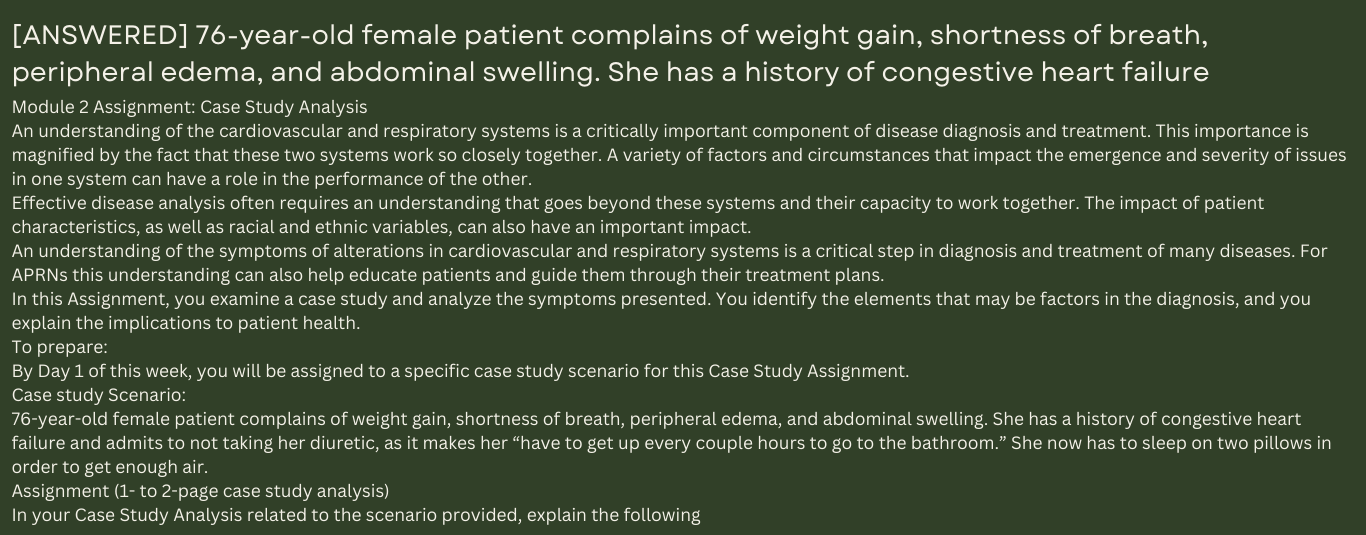[ANSWERED] 76-year-old female patient complains of weight gain, shortness of breath, peripheral edema, and abdominal swelling. She has a history of congestive heart failure and admits
76-year-old female patient complains of weight gain, shortness of breath, peripheral edema, and abdominal swelling. She has a history of congestive heart failure and admits

Module 2 Assignment: Case Study Analysis
An understanding of the cardiovascular and respiratory systems is a critically important component of disease diagnosis and treatment. This importance is magnified by the fact that these two systems work so closely together. A variety of factors and circumstances that impact the emergence and severity of issues in one system can have a role in the performance of the other.
Effective disease analysis often requires an understanding that goes beyond these systems and their capacity to work together. The impact of patient characteristics, as well as racial and ethnic variables, can also have an important impact.
An understanding of the symptoms of alterations in cardiovascular and respiratory systems is a critical step in diagnosis and treatment of many diseases. For APRNs this understanding can also help educate patients and guide them through their treatment plans.
In this Assignment, you examine a case study and analyze the symptoms presented. You identify the elements that may be factors in the diagnosis, and you explain the implications to patient health.
To prepare:
By Day 1 of this week, you will be assigned to a specific case study scenario for this Case Study Assignment.
Case study Scenario:
76-year-old female patient complains of weight gain, shortness of breath, peripheral edema, and abdominal swelling. She has a history of congestive heart failure and admits to not taking her diuretic, as it makes her “have to get up every couple hours to go to the bathroom.” She now has to sleep on two pillows in order to get enough air.
Assignment (1- to 2-page case study analysis)
In your Case Study Analysis related to the scenario provided, explain the following
- The cardiovascular and cardiopulmonary pathophysiologic processes that result in the patient presenting these symptoms.
- Any racial/ethnic variables that may impact physiological functioning.
- How these processes interact to affect the patient.
Verified Expert Answer
Introduction
The cardiopulmonary system is one of the most crucial organ systems as it helps in availing oxygen to the crucial organs of the body for the metabolism of energy for various roles. Diseases which affect the respiratory and the cardiovascular system often lead to a decline in the function of many other systems of the body (Andrade et al., 2020; McCance & Huether, 2019). In this essay, a case scenario is used to discuss the patient characteristics and to recommend the most suitable treatment rationale.
The client is a 76 y.o female pt. who reports with complaints of SOB, weight gain, peripheral edema, and abdominal swelling. Further examination shows that she has frequent shortness of breath at night and also has a history of heart failure. A closer assessment of the various pathophysiologic processes reveals that she is most likely to suffer from pneumonia.
Cardiopulmonary/ Cardiovascular Pathophysiologic Processes Leading to the
Symptoms
The condition affecting the patient is as a direct result of the presence of a pathogen in the breathing system, where the alveoli are attacked and invoke a response which causes various body changes (McCance & Huether, 2019). Specifically, when the pathogen reaches the alveoli, the host defense mechanism is activated and there are multiple deposits of white blood cells in the alveoli lining, which clogs the pathway for passing oxygen to the blood vessels (Siddiqi & Ruberg, 2018).
As a result, much of the air that the patient breathes in is not utilized, and they have to take multiple breaths to fulfil their oxygen needs, hence the occurrence of shortness of breath. The attacks of the microorganisms could be from sinusitis, nasal carriers, hematogenous spread, and oropharynx.
Ethnic/Racial Variables that Could Influence the Physiological Functioning
One of the racial variables that the client may experience is the idea of some racial groups having more susceptibility to attacks compared to others. For example, African Americans have a higher tendency of being victims of pneumonia compared to Whites. While it may not be possible to explain the rationale behind this difference, it is evident that some of the explanations could lie behind the behaviors (Sehgal et al., 2016).
For example, African Americans are more exposed to several risk behaviors such as smoking. Another reason for the variance could be because of the absence of optimal levels of alpha-carotene among Africans, which makes it hard for them to have enough functioning ability in the cases of limited oxygen such as in pneumonia attacks (Sehgal et al., 2016).
How the mentioned Processes network to affect the Patient
The symptoms shown often render the patient inactive since they cannot engage in work activities for a long period of time. Also, the work environment of the patient becomes limited as they can no longer work in industries or environments where there are numerous air pollutants that limit their ability to access enough oxygen (McCance & Huether, 2019). Another limitation that the patient could have following the diagnosis with the condition is the prohibition to engage in strenuous exercises.
This limitation could lead to higher problems that are associated with dormancy, including but not limited to lifestyle problems like obesity (Gabriel-Costa, 2018). In case the reduced oxygen volumes becomes extreme, the brain function could also be affected in that the patient could encounter symptoms of reduced brain function and get higher problems such as dementia (Siddiqi & Ruberg, 2018). Similarly, the heart function could be affected where the cardiac muscles fail to get enough nourishment, which could ultimately lead to things such as heart attack.
As part of the therapy, the patient may need to take antibiotics such as Clindamycin and Fluoroquinolones such as Delafloxacin (Li et al., 2021). Delafloxacin is likely to be effective in treating the condition but it has numerous side effects that the client would have to bear with during the entire therapy period (Li et al., 2021). For example, the client would find chest pain, tingling feelings, cold sweats, and also experience anxiety.
On a positive note, however, these processes could help the patient to correct many other problems in the body that they were possibly unaware about. That is, the antibiotics act generally, and they could help to treat an infection that was unidentified in the liver or in another organ where it was not likely for the client to identify it early enough.
Conclusion
Pneumonia is a condition which entails various cardiovascular and respiratory processes that affect the patient in different ways. Among the chief characteristics or symptoms present in pneumonia patients is the shortness of breath which is as a direct result of the blocking of the pathway used to pass inhaled oxygen to the blood vessels in the alveoli.
The patient shown in the case study would have to seek treatment in a timely fashion lest the condition would advance to affect other organs of the body and lead to higher diseases such as cardiac arrest or brain damage. The treatment plan for the condition should also be considerate of the side effects, as some of them could affect the patient negatively to worsen her healing process.
References
Andrade, J. G., Aguilar, M., Atzema, C., Bell, A., Cairns, J. A., Cheung, C. C., & Khairy, P. (2020). The 2020 Canadian Cardiovascular Society/Canadian Heart Rhythm Society Comprehensive Guidelines for the Management of Atrial Fibrillation. Canadian Journal of Cardiology. https://doi.org/10.1016/j.cjca.2020.09.001
Gabriel-Costa, D. (2018). The pathophysiology of myocardial infarction-induced heart failure. Pathophysiology, 25(4), 277-284. https://doi.org/10.1016/j.pathophys.2018.04.003
Li, X., Tang, H., Tang, Q., & Chen, W. (2021). Decoding the Mechanism of Huanglian Jiedu Decoction in Treating Pneumonia Based on Network Pharmacology and Molecular Docking. Frontiers in cell and developmental biology, 9, 81. https://doi.org/10.3389/fcell.2021.638366
McCance, K. L. & Huether, S. E. (2019). Pathophysiology: The biologic basis for disease in adults and children (8th ed.). St. Louis, MO: Mosby/Elsevier.
Sehgal, A., Malikiwi, A., Paul, E., Tan, K., & Menahem, S. (2016). A new look at bronchopulmonary dysplasia: postcapillary pathophysiology and cardiac dysfunction. Pulmonary circulation, 6(4), 508-515. https://doi.org/10.1086/688641
Siddiqi, O. K., & Ruberg, F. L. (2018). Cardiac amyloidosis: an update on pathophysiology, diagnosis, and treatment. Trends in cardiovascular medicine, 28(1), 10-21. https://doi.org/10.1016/j.tcm.2017.07.004
Place your order now for a similar assignment and get fast, cheap and best quality work written by our expert level assignment writers. Use Coupon Code: NEW30 to Get 30% OFF Your First Order
Use Coupon Code: NEW30 to Get 30% OFF Your First Order
FAQs
- Which heart failure causes peripheral edema?
- What does edema of the abdomen in patients with heart failure indicate?
Rubric Detail
Select Grid View or List View to change the rubric’s layout.
Name: NURS_6501_Module2_Case Study_Assignment_Rubric
| Excellent | Good | Fair | Poor | |||
| Develop a 1- to 2-page case study analysis, examing the patient symptoms presented in the case study. Be sure to address the following:
Explain both the cardiovascular and cardiopulmonary pathophysiologic processes of why the patient presents these symptoms. |
28 (28%) – 30 (30%)
The response accurately and thoroughly describes the patient symptoms. The response includes accurate, clear, and detailed reasons, with explanation for both the cardiovascular and cardiopulmonary pathophysiologic processes supported by evidence and/or research, as appropriate, to support the explanation. |
25 (25%) – 27 (27%)
The response describes the patient symptoms. The response includes accurate reasons, with explanation for both the cardiovascular and cardiopulmonary pathophysiologic processes supported by evidence and/or research, as appropriate, to support the explanation. |
23 (23%) – 24 (24%)
The response describes the patient symptoms in a manner that is vague or inaccurate. The response includes reasons for the cardiovascular and/or cardiopulmonary pathophysiologic processes, with explanations that are vague or based on inappropriate evidence/research. |
0 (0%) – 22 (22%)
The response describes the patient symptoms in a manner that is vague and inaccurate, or the description is missing. The response does not include reasons for either the cardiovascular or cardiopulmonary pathophysiologic processes, or the explanations are vague or based on inappropriate or no evidence/research. |
||
| Explain how the cardiovascular and cardiopulmonary pathophysiologic processes interact to affect the patient. | 28 (28%) – 30 (30%)
The response includes an accurate, complete, detailed, and specific explanation of how the cardiovascular and cardiopulmonary pathophysiologic processes interact to affect the patient. |
25 (25%) – 27 (27%)
The response includes an accurate explanation of how the cardiovascular and cardiopulmonary pathophysiologic processes interact to affect the patient. |
23 (23%) – 24 (24%)
The response includes a vague or inaccurate explanation of how the cardiovascular and cardiopulmonary pathophysiologic processes interact to affect the patient. |
0 (0%) – 22 (22%)
The response includes a vague or inaccurate explanation of how the cardiovascular and cardiopulmonary pathophysiologic processes interact to affect the patient. |
||
| Explain any racial/ethnic variables that may impact physiological functioning. | 23 (23%) – 25 (25%)
The response includes an accurate, complete, detailed, and specific explanation of racial/ethnic variables that may impact physiological functioning supported by evidence and/or research, as appropriate, to support the explanation. |
20 (20%) – 22 (22%)
The response includes an accurate explanation of racial/ethnic variables that may impact physiological functioning supported by evidence and/or research, as appropriate, to support the explanation. |
18 (18%) – 19 (19%)
The response includes a vague or inaccurate explanation of racial/ethnic variables that may impact physiological functioning, and/or explanations based on inappropriate evidence/research. |
0 (0%) – 17 (17%)
The response includes a vague or inaccurate explanation of racial/ethnic variables that may impact physiological functioning, or the explanations are based on inappropriate or no evidence/research. |
||
| Written Expression and Formatting – Paragraph Development and Organization: Paragraphs make clear points that support well-developed ideas, flow logically, and demonstrate continuity of ideas. Sentences are carefully focused—neither long and rambling nor short and lacking substance. A clear and comprehensive purpose statement and introduction are provided that delineate all required criteria. |
5 (5%) – 5 (5%)
Paragraphs and sentences follow writing standards for flow, continuity, and clarity. A clear and comprehensive purpose statement, introduction, and conclusion are provided that delineate all required criteria. |
4 (4%) – 4 (4%)
Paragraphs and sentences follow writing standards for flow, continuity, and clarity 80% of the time. Purpose, introduction, and conclusion of the assignment are stated, yet are brief and not descriptive. |
3 (3%) – 3 (3%)
Paragraphs and sentences follow writing standards for flow, continuity, and clarity 60%–79% of the time. Purpose, introduction, and conclusion of the assignment are vague or off topic. |
0 (0%) – 2 (2%)
Paragraphs and sentences follow writing standards for flow, continuity, and clarity < 60% of the time. No purpose statement, introduction, or conclusion were provided. |
||
| Written Expression and Formatting – English Writing Standards: Correct grammar, mechanics, and proper punctuation |
5 (5%) – 5 (5%)
Uses correct grammar, spelling, and punctuation with no errors. |
4 (4%) – 4 (4%)
Contains a few (1 or 2) grammar, spelling, and punctuation errors. |
3 (3%) – 3 (3%)
Contains several (3 or 4) grammar, spelling, and punctuation errors. |
0 (0%) – 2 (2%)
Contains many (≥ 5) grammar, spelling, and punctuation errors that interfere with the reader’s understanding. |
||
| Written Expression and Formatting – The paper follows correct APA format for title page, headings, font, spacing, margins, indentations, page numbers, running heads, parenthetical/in-text citations, and reference list. | 5 (5%) – 5 (5%)
Uses correct APA format with no errors. |
4 (4%) – 4 (4%)
Contains a few (1 or 2) APA format errors. |
3 (3%) – 3 (3%)
Contains several (3 or 4) APA format errors. |
0 (0%) – 2 (2%)
Contains many (≥ 5) APA format errors. |
||
| Total Points: 100 | ||||||
Name: NURS_6501_Module2_Case Study_Assignment_Rubric


